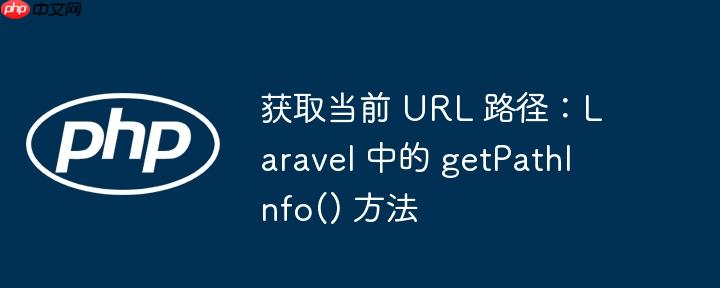
在 Laravel 开发中,经常需要获取当前请求的 URL 路径,以便进行路由判断、权限验证或其他业务逻辑处理。虽然 Route::current()->uri() 方法可以获取 URL 路径,但它不包含前导斜杠。本文将介绍如何使用 request()->getPathInfo() 方法来获取包含前导斜杠的完整 URL 路径。
正如摘要所述,request()->getPathInfo() 方法是获取包含斜杠的当前 URL 路径的关键。
<?php $path = request()->getPathInfo(); // 假设当前 URL 是 https://example.com/test // $path 的值将是 "/test" echo $path; ?>
上述代码片段展示了如何使用 request()->getPathInfo() 方法。request() 函数返回当前请求的实例,该实例继承自 Symfony 的 Request 类。getPathInfo() 方法是 Symfony Request 类提供的方法,用于获取 URL 路径信息,包括前导斜杠。
深入理解 getPathInfo()
getPathInfo() 方法的实现位于 Symfony 的 Request 类中。它主要用于解析请求的 URL,并提取出路径信息。
// Symfony\Component\HttpFoundation\Request.php
public function getPathInfo(): string
{
if (null === $this->pathInfo) {
$this->pathInfo = $this->preparePathInfo();
}
return $this->pathInfo;
}注意事项
示例:在中间件中使用 getPathInfo()
以下示例展示了如何在中间件中使用 getPathInfo() 方法进行权限验证:
<?php
namespace App\Http\Middleware;
use Closure;
class CheckPermission
{
/**
* Handle an incoming request.
*
* @param \Illuminate\Http\Request $request
* @param \Closure $next
* @return mixed
*/
public function handle($request, Closure $next)
{
$path = $request->getPathInfo();
// 根据 $path 进行权限验证
if (! $this->hasPermission($path)) {
abort(403, 'Unauthorized.');
}
return $next($request);
}
private function hasPermission($path)
{
// 实现权限验证逻辑
// 例如,查询数据库或使用配置文件
return true; // 假设所有路径都有权限
}
}总结
request()->getPathInfo() 方法是 Laravel 中获取包含前导斜杠的当前 URL 路径的有效方法。它基于 Symfony 的 Request 类,提供了可靠的路径解析功能。通过理解 getPathInfo() 方法的工作原理和注意事项,开发者可以更好地利用它来处理 URL 相关的业务逻辑。
以上就是获取当前 URL 路径:Laravel 中的 getPathInfo() 方法的详细内容,更多请关注php中文网其它相关文章!

每个人都需要一台速度更快、更稳定的 PC。随着时间的推移,垃圾文件、旧注册表数据和不必要的后台进程会占用资源并降低性能。幸运的是,许多工具可以让 Windows 保持平稳运行。

Copyright 2014-2025 https://www.php.cn/ All Rights Reserved | php.cn | 湘ICP备2023035733号